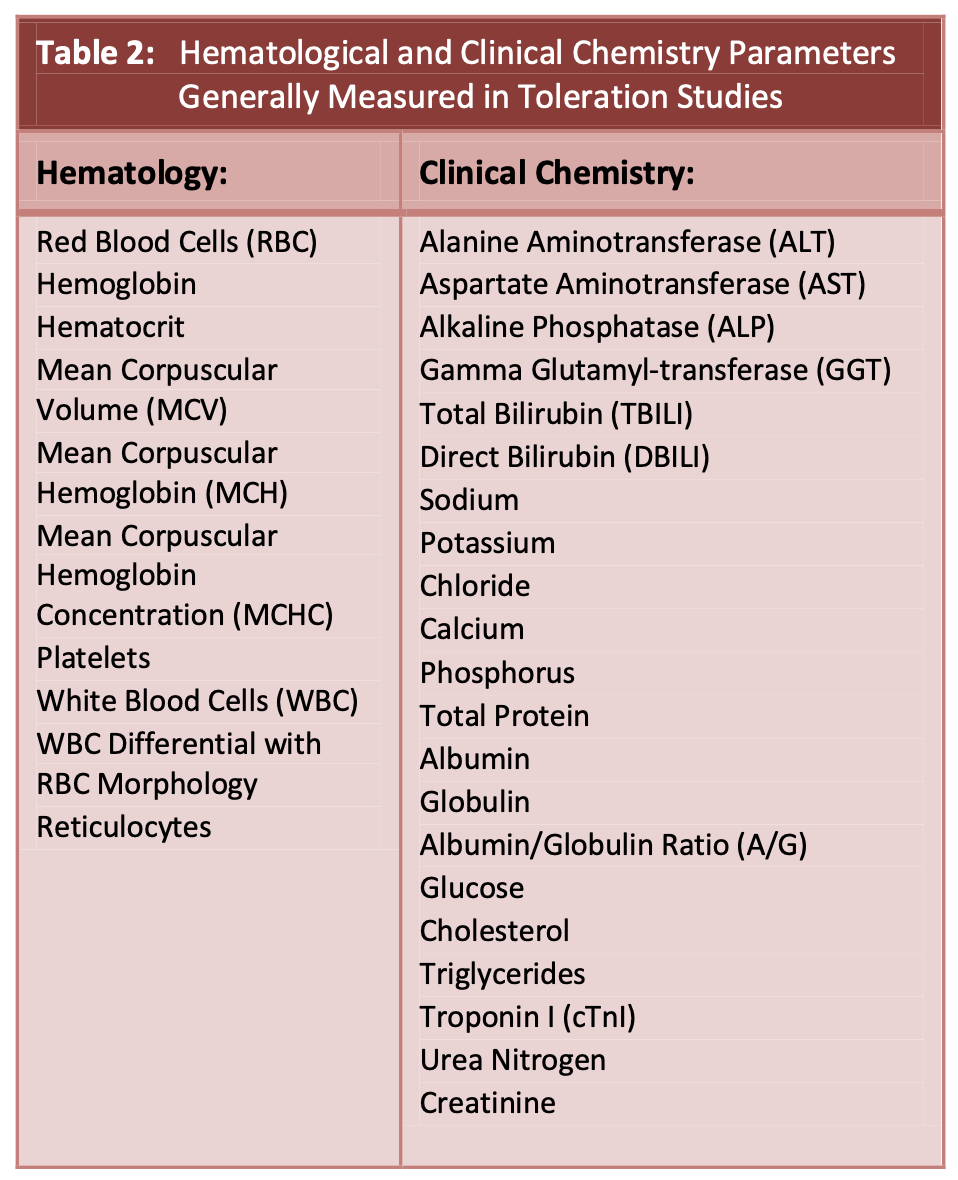Summary
Things one aims to learn from a toleration (dose range finding) study
- Maximum tolerated dose (MTD)
- Early dose and time-related toxicological effects
- Dose selection for GLP tox studies
Study design
- Usually conducted in both rats and dogs (sometimes primates)
- Single dose escalation (SDE)
- Rats and dogs receive single doses of drug over a large dose range (25-2000 mg/kg for rats, 50 and 250 mg/kg for dogs)
- Repeat dose (RD) phase
- Drug is repeatedly dosed (how often?) at 3 dose levels (informed by results from SDE phase) over a 14 day period
Things that get measured
- Clinical observations
-
Body weight is measured pre-dose, once weekly, after the last dose, and prior to necropsy

- Righting reflex: ability to go back to normal when flipped over or put on the side
- Prostration: animal is stretched out on the ground, indicating severe weakness or illness
- Catatonia: maintaining postures for abnormal amounts of time, immobility
- Ataxia: wobbly or unstable walking, jerky movements
- Tonic convulsions: sustained muscle contraction leading to stiffness or rigidity
- Clonic convulsions: rhythmic muscle contractions leading to jerking
- Erythema: red or pink patches on skin
- Edema: swelling caused by accumulation of fluid
- Alopecia: hair loss/thinning
- Piloerection: goosebumps, hair standing up
- Miosis: narrowing of pupils
- Mydriasis: enlargement of pupils
- Exophthlamia: abnormal bulging of eyeball
- Conjunctiva: tissue covering the front of the eye (possible inflammation)
- Palpebral fissure: eye opening (size and appearance)
- Dyspnea: difficulty breathing
- Apnea: temporary pause in breathing
- Tachypnea: rapid breathing
- Buccal stain: stain on cheek area
-
Clinical observations are collected at the following time points
- SDE: predose, several times post dose
- RD: predose, and at the anticipated maximal serum concentration
-
- Clinical pathology
- SDE: blood collected 24 hrs post-dose
-
RD: blood collected after last of repeat doses

- ALT: enzyme present in hepatocytes that leaks into the blood following cell damage
- AST: enzyme in liver parenchymal cells whose elevation in serum levels suggests liver damage. Also found in red blood cells and skeletal muscle.
- Elevated ALT and AST tend to be non-specific but can provide some evidence for liver cell injury
- Total bilirubin
- increases can indicate intervascular hemolysis (destruction of red blood cells)
- decreases can indicate deficiency in hepatic metabolism or obstruction of the bile ducts
- ALP: enzyme found in cells lining biliary ducts of the liver (also kidney, bone, and placental tissue)
- Increases can indicate liver damage or bile duct obstruction
- GGT: enzyme that transports amino acids across hepatic, renal, and biliary cells
- Increase is closely associated with biliary damage
- Pathology/histopathology
- Pathology is conducted to determine the cause of death for animals that die or are euthanized earlier than planned
- Also conducted in regularly euthanized animals

- Microscopic examination occurs after tissues are fixed and stained with H&E
- Toxicokinetics
- SDE in rodents: TK measured post-dose at various time points (around projected time for maximal plasma concentration up to 24 hrs after dosing)
- SDE in dogs and RD in dogs/rodents: TK measured at multiple time points (e.g. 1, 2, 4, 7, 24 hours). From this, cmax (maximum serum concentration), tmax (time to maximum serum concentration), and AUC are computed
- Toxicogenomics
- Gene expression analysis sometimes conducted in rats
- Samples collected at single dose but at 3 dose levels from RD phase from blood and liver tissue
- Expression of cytochrome P450 and various other markers of liver function are measured
- GE analysis sometimes also in human hepatocyte (liver cell) cell lines
- Gene expression analysis sometimes conducted in rats